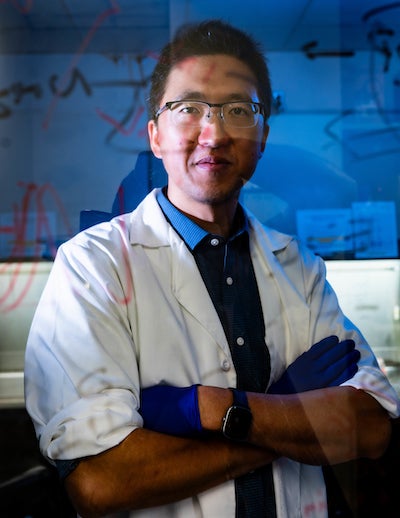Rice University chemist Han Xiao has won a $3.2 million research project (R01) grant from the National Cancer Institute to develop the first tissue-specific epigenetic inhibitor to treat bone metastasis.

Epigenetic inhibitors restrict the activity of certain molecules that influence gene expression without acting directly on DNA. Xiao and his team aim to modify two epigenetic inhibitor drugs ⎯ one that is already approved by the U.S. Food and Drug Administration and one that is currently in clinical trials ⎯ with small-molecule compounds known as bisphosphonates, a class of drugs used to prevent bone density-loss associated with osteoporosis and other similar conditions. The modification will allow the drugs to target metastatic lesions on bone tissue without impacting the epigenetic profile of other normal body organs or systems.
Though focused primarily on breast cancer patients, the research could impact a broader patient population, including those suffering from rare cancers like Ewing sarcoma.
“Bone metastasis is the leading type of metastasis for breast, prostate, lung, kidney and thyroid cancers,” Xiao said. “We don’t have very good treatments for patients with bone metastasis, or metastasis in general. Right now, the drugs intended for the treatment of a primary breast cancer tumor, for example, are also used for the metastatic patients. Thus, individuals with bone metastasis generally have a poor response to these therapies.”
As more than two-thirds of bone metastases are associated with subsequent metastases to other organs ⎯ a major cause of cancer-related deaths ⎯ the research is strategically poised to intervene at a critical juncture in the progression of the disease by interrupting a mechanism known as “metastasis-to-metastasis.” Another reason why bone is a particularly apt therapeutic target is because it can prime cancer cells, making them more aggressive.
“What scientists have found is that, for a majority of multiorgan metastasis cases, the cancer comes from bone seeding, meaning it first goes through the bone and then to other organs,” Xiao said. “If we develop a way to stop these cancer cells in the bone, we can then prevent them from spreading to other organs.”
The research targets the EZH2 enzyme that functions as an epigenetic regulator, modifying histones, proteins that serve as structural support for DNA.
“Each tissue or cell type has its own epigenetic patterns,” Xiao said. “What we are trying to do is target this epigenetic environment of the cancer cell in the bone without changing the epigenetic environment in other tissues.”
Increased EZH2 activity plays a role in multiple cancers and is associated with poor survival outcomes in metastatic patients. Using small-molecule inhibitors to dampen the enzyme’s function can significantly reduce cancer cell growth. However, inhibiting EZH2 has unwanted secondary effects, such as increased toxicity and impoverished immune cell function.
“Right now, epigenetic inhibitor drugs are systematically administered to the whole body, which means the epigenetic profile of all cells gets modified indiscriminately,” Xiao said. “In addition to reducing the tumor’s metastatic potential ⎯ which is great ⎯ these drugs can also reduce immune cells’ antitumor activity ⎯ something we don’t want to happen.”
Bisphosphonates prefer binding to bone tumor sites rather than to healthy tissue, which means they can guide the EZH2-inhibiting molecules right where they are needed. In a preliminary study, the uptake of the modified drug in bone tumor sites is 10-20 times higher than the unmodified treatment.
“I think our drug could be applied not only against breast cancer, but also against prostate and bone cancers more generally,” Xiao said. “We think this can have a broad impact.”
In addition to drug development and testing, Xiao and collaborators plan to map out the therapeutic mechanism of action and explore its potential to enhance other forms of therapy, such as immunotherapy and checkpoint inhibitor-based therapies. The Xiao lab will work together with Xiang Zhang and his group at the Baylor College of Medicine on the project.
Xiao is a Norman Hackerman-Welch Young Investigator, a CPRIT Scholar in Cancer Research and an associate professor of chemistry, bioengineering and biosciences at Rice. Zhang is a William T. Butler Endowed Chair for Distinguished Faculty at Baylor, a McNair Scholar and a professor of molecular and cellular biology.
- Image Downloads:
-
https://news-network.rice.edu/news/files/2023/07/230707_Xiao_Fitlow_269.jpg
CAPTION: Han Xiao is a Norman Hackerman-Welch Young Investigator, a CPRIT Scholar in Cancer Research and an associate professor of chemistry, bioengineering and biosciences at Rice University. (Photo by Jeff Fitlow/Rice University)
https://news-network.rice.edu/news/files/2023/07/230707_Xiao_Fitlow_259.jpg
CAPTION: Han Xiao is a Norman Hackerman-Welch Young Investigator, a CPRIT Scholar in Cancer Research and an associate professor of chemistry, bioengineering and biosciences at Rice (Photo by Jeff Fitlow/Rice University) - Related stories:
-
Rice, Baylor developing ‘glyco-immune’ checkpoint inhibitor:
https://news.rice.edu/news/2023/rice-baylor-developing-glyco-immune-checkpoint-inhibitorAntibody with engineered peptide targets bone metastasis:
https://news.rice.edu/news/2022/antibody-engineered-peptide-targets-bone-metastasis
Rice, Baylor win defense grant to advance metastasis study:
https://news2.rice.edu/2021/08/19/rice-baylor-win-defense-grant-to-advance-metastasis-study/
Drug doubles down on bone cancer, metastasis:
https://news.rice.edu/news/2021/drug-doubles-down-bone-cancer-metastasis
- Links:
-
The Xiao lab: https://xiao.rice.edu/People/hanxiao/hanxiao.html
Rice Department of Chemical and Biomolecular Engineering: https://chbe.rice.edu/
Rice Department of Chemistry: https://chemistry.rice.edu/George R. Brown School of Engineering: https://engineering.rice.edu
Bioscience Research Collaborative: https://brc.rice.edu/
- About Rice:
-
Located on a 300-acre forested campus in Houston, Rice University is consistently ranked among the nation’s top 20 universities by U.S. News & World Report. Rice has highly respected schools of Architecture, Business, Continuing Studies, Engineering, Humanities, Music, Natural Sciences and Social Sciences and is home to the Baker Institute for Public Policy. With 4,552 undergraduates and 3,998 graduate students, Rice’s undergraduate student-to-faculty ratio is just under 6-to-1. Its residential college system builds close-knit communities and lifelong friendships, just one reason why Rice is ranked No. 1 for lots of race/class interaction and No. 4 for quality of life by the Princeton Review. Rice is also rated as a best value among private universities by Kiplinger’s Personal Finance.

